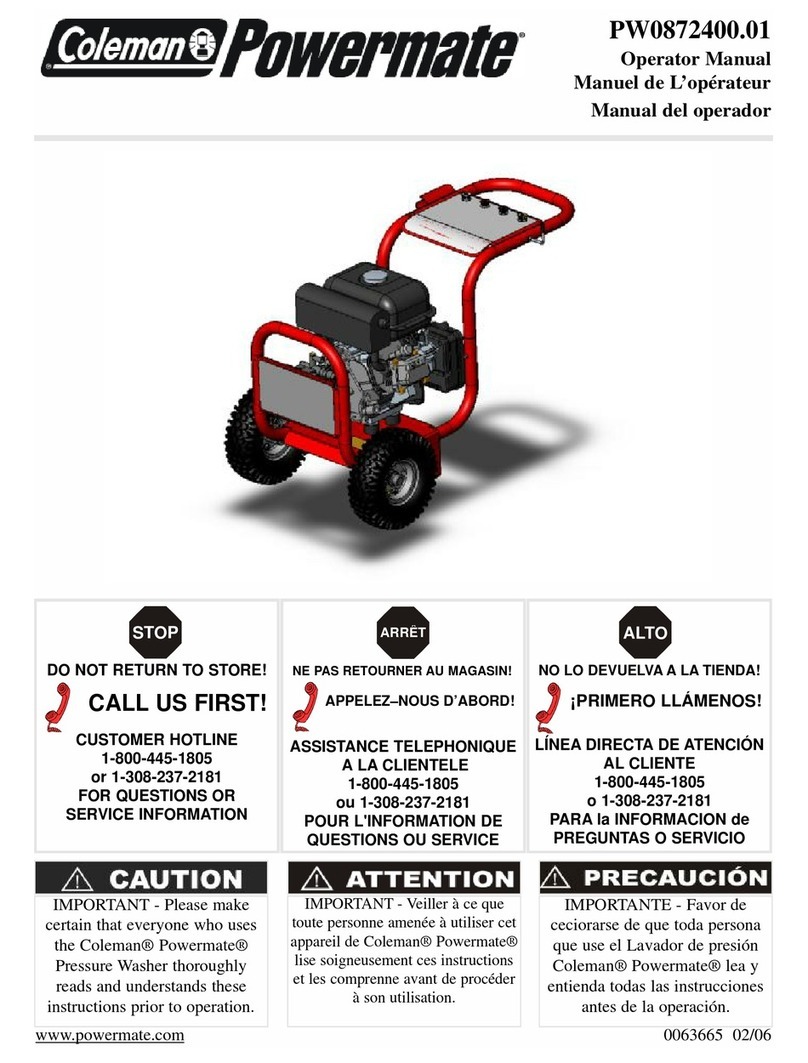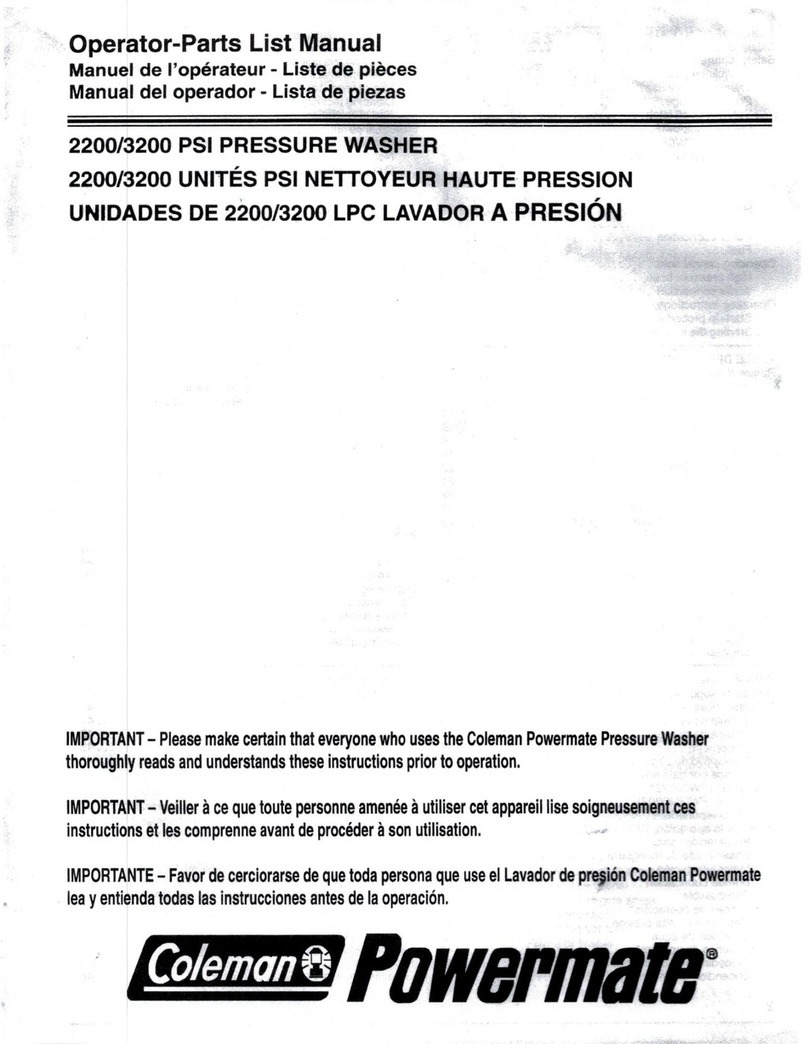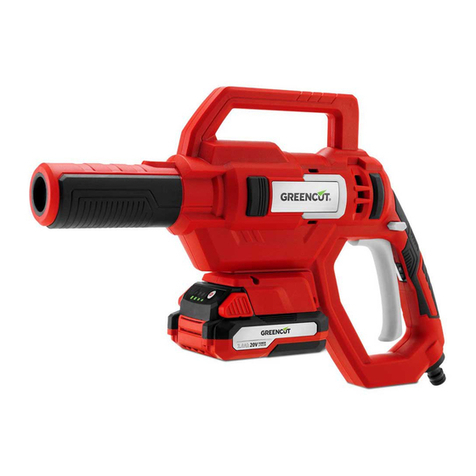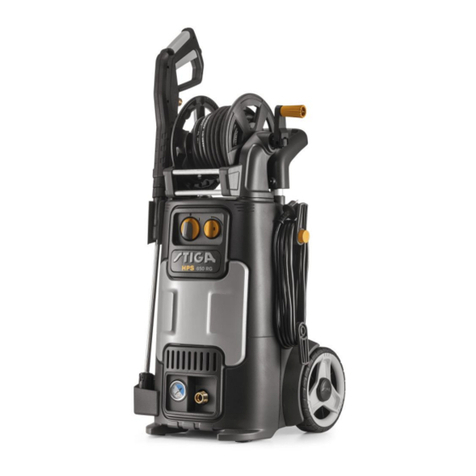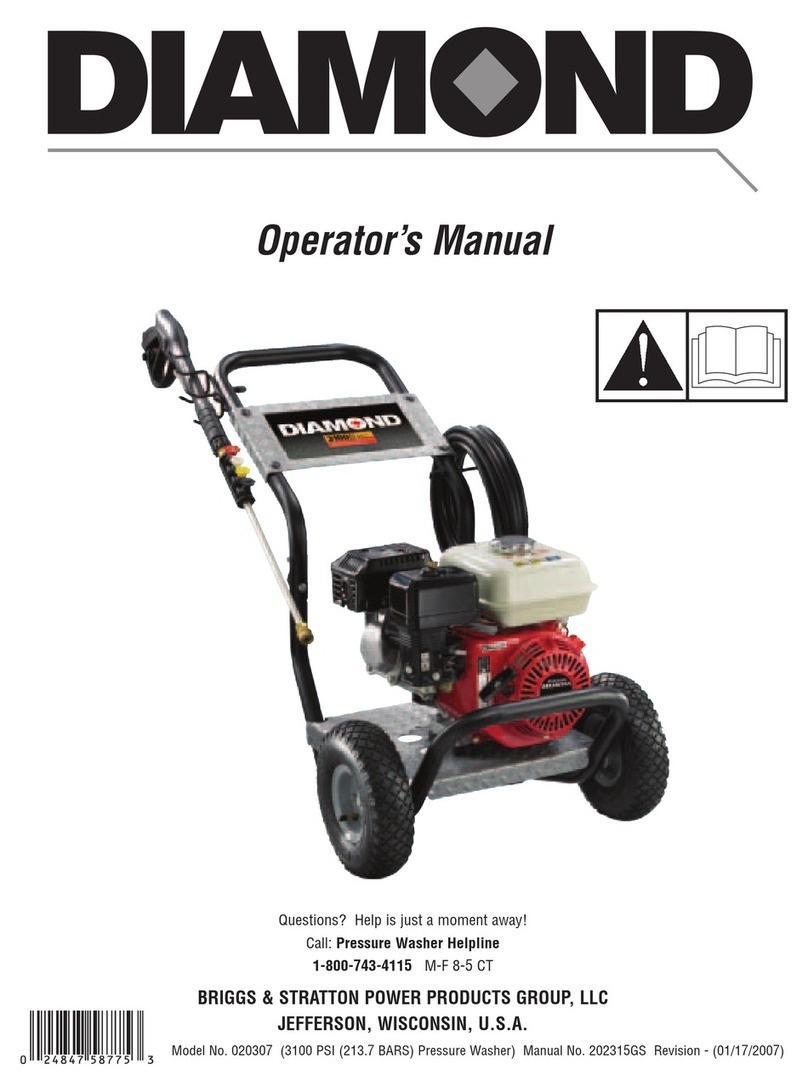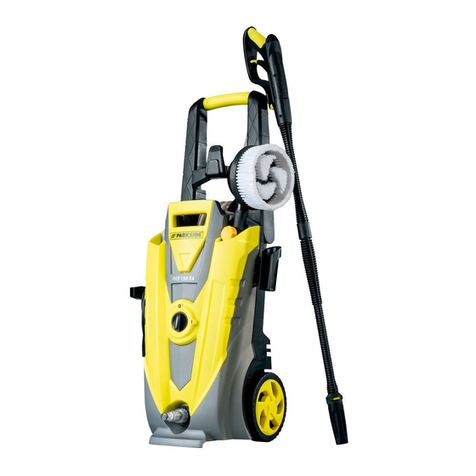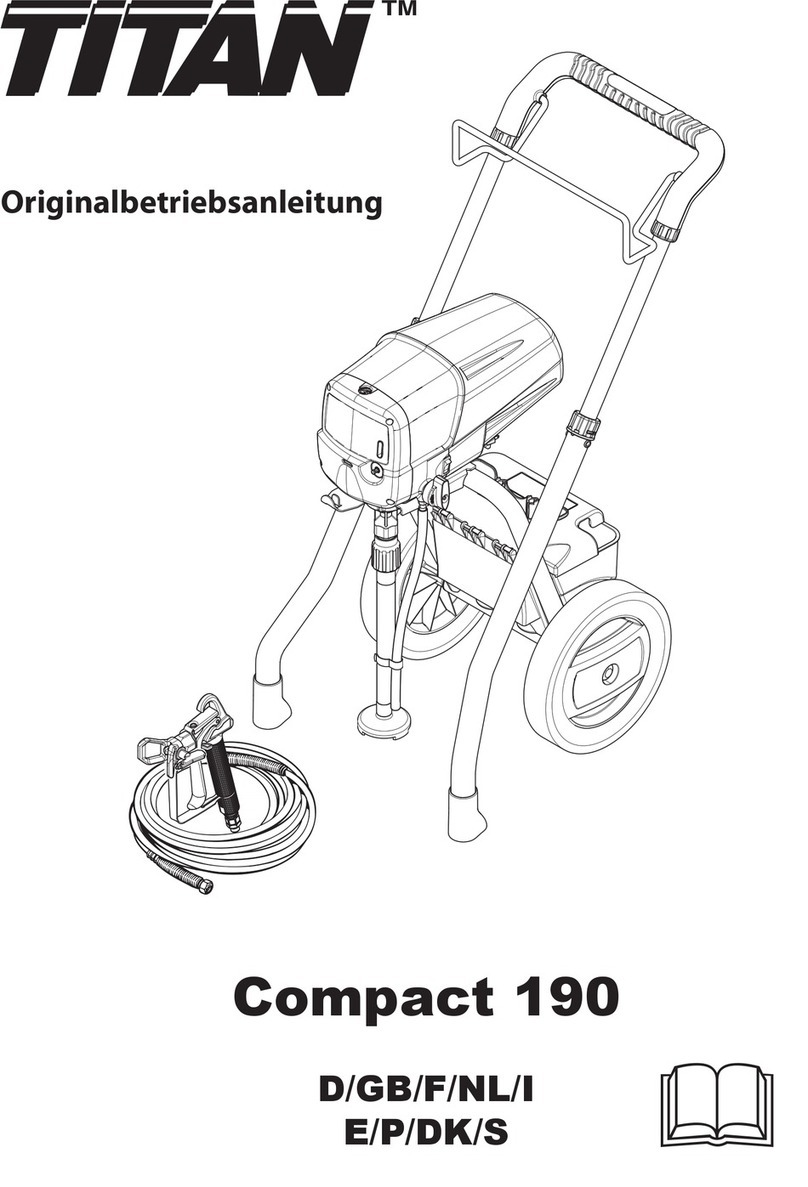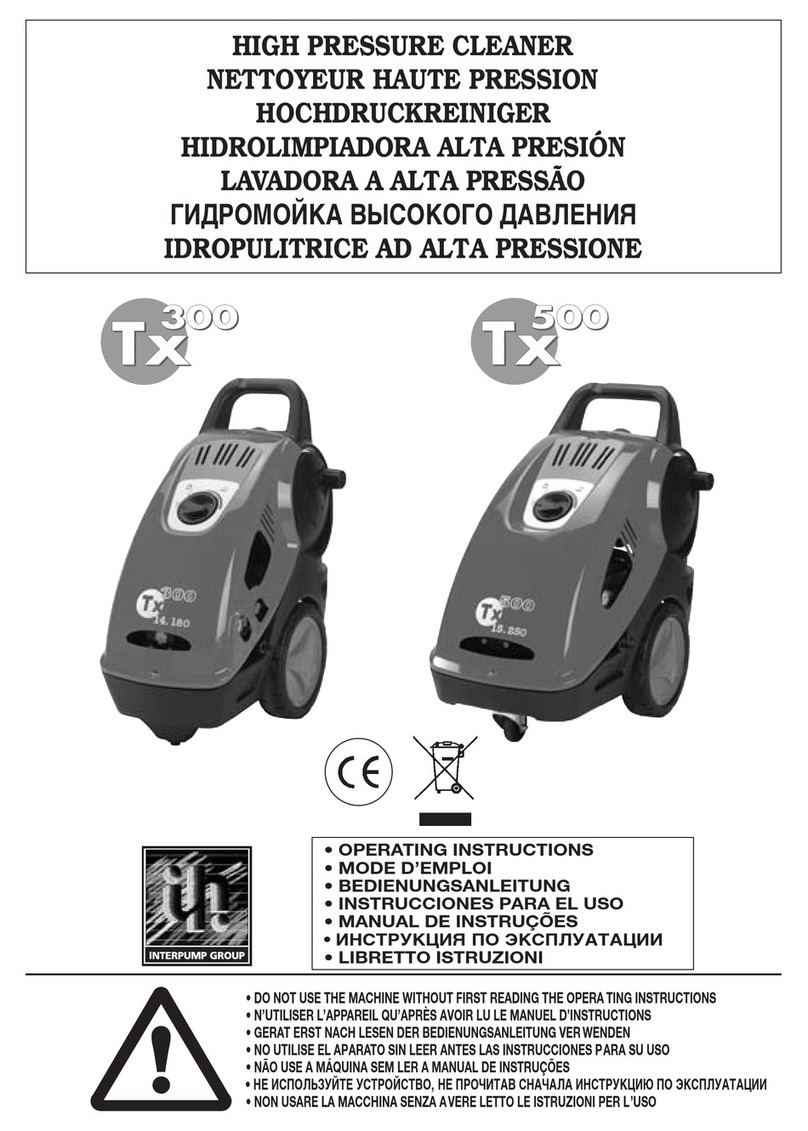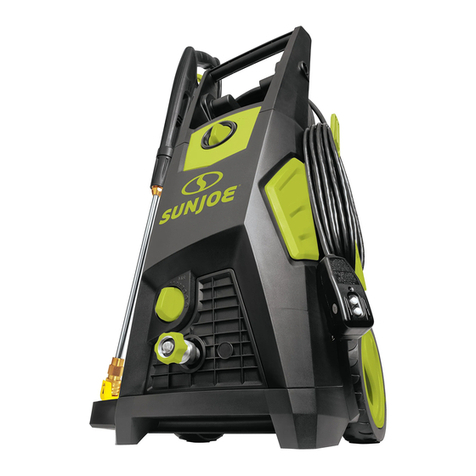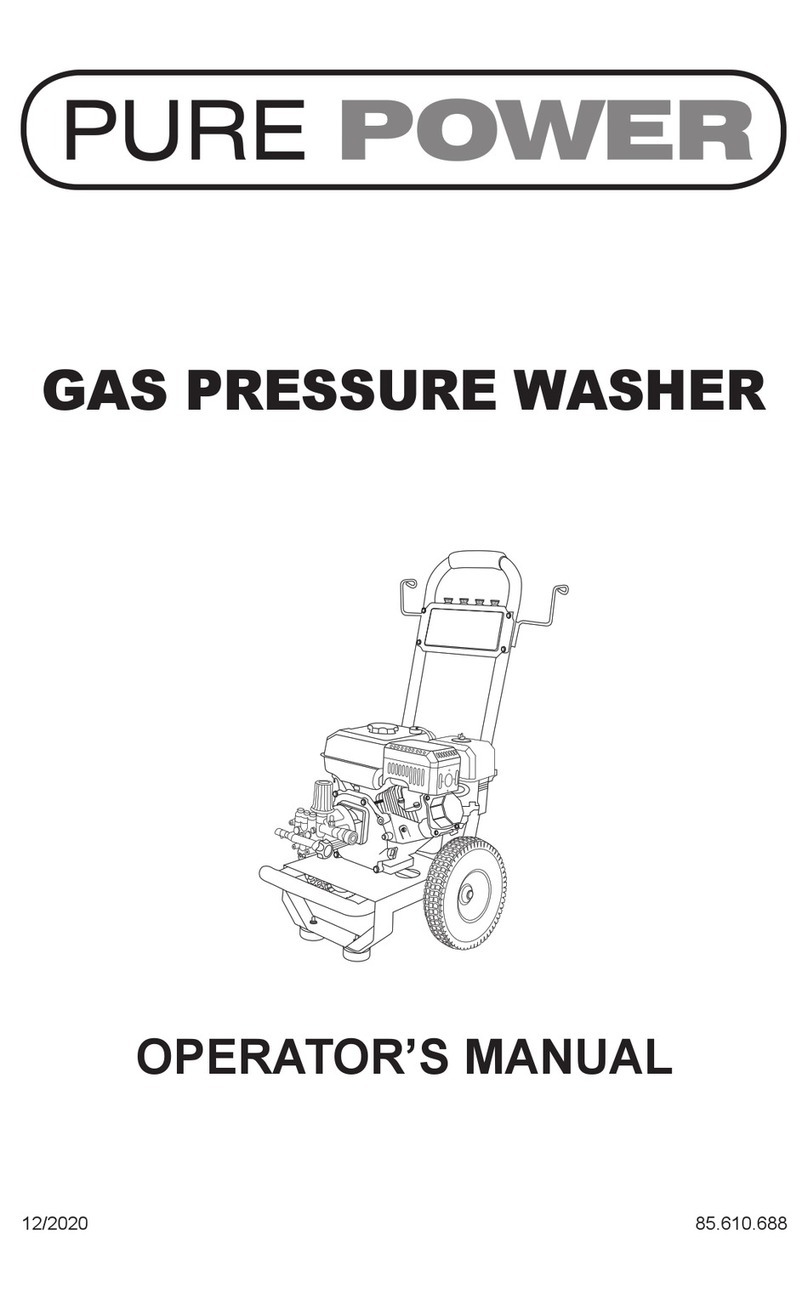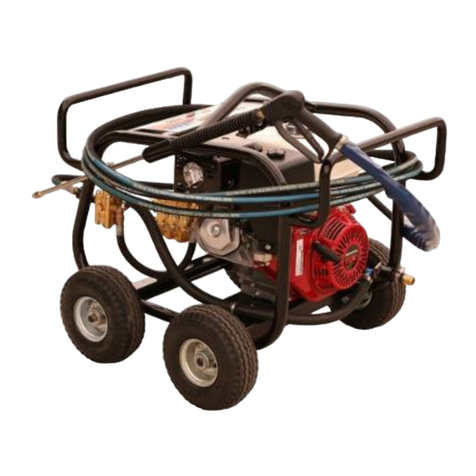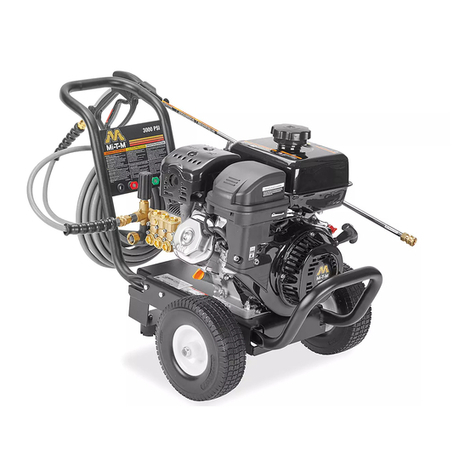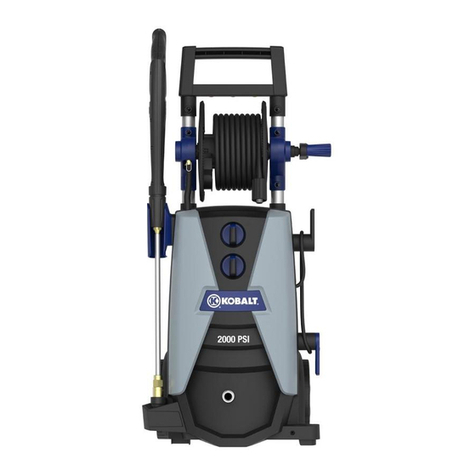Powermate PW0501500 User manual

Operator’s Manual
Manuel de l'utilisateur
Manual del Usuario
Model: PW0501500
1500 PSI
Modèle : PW0501500
103,4 bar (1 500 PSI)
Modelo : PW0501500.NOM
10,34MPa ( 1500 PSI )
200-2657_Rev A_4-07
WARNING: Read and understand all safety precautions in this manual before operating. Failure to comply with
instructions in this manual could result in personal injury, property damage, and/or voiding of your warranty. The
manufacturer WILL NOT be liable for any damage because of failure to follow these instructions.
AVERTISSEMENT : Lisez et veillez à bien comprendre toutes les consignes de sécurité de ce manuel avant
d'utiliser l'appareil. Toute dérogation aux instructions contenues dans ce manuel peut entraîner l'annulation de la
garantie, causer des blessures et/ou des dégâts matériels. Le fabricant NE SAURA être tenu responsable de
dommages résultant de l'inobservation de ces instructions.
ADVERTENCIA: Lea y comprenda todas las precauciones de seguridad contenidas en este manual antes de
utilizar esta unidad. Si no cumple con las instrucciones de este manual podría ocasionar lesiones personales,
daños a la propiedad y/o la anulación de su garantía. El fabricante NO SERÁ responsable de ningún daño por
no acatar estas instrucciones.
This product is covered by US Patents and other international patents.
Ce produit est protégé par des brevets américains et d’autres brevets internationaux.
Este producto se encuentra cubierto por patentes de EE.UU. y otros patentes internacionales.
ENGLISH Pages 2-12
FRANCAIS Pages 13-23
ESPAÑOL Páginas 24-34

2
INDEX
1.0 SAFETY AND OPERATION RULES. . . . . . . . . . . . . . . . . . . . . . . . . . . . . . . . . . . . . . . . . . . . . . . . . . page 3
INSTALLATION . . . . . . . . . . . . . . . . . . . . . . . . . . . . . . . . . . . . . . . . . . . . . . . . . . . . . . . . . . . . . . . . . . pages 4-6
PARTS DRAWING/PARTS LIST. . . . . . . . . . . . . . . . . . . . . . . . . . . . . . . . . . . . . . . . . . . . . . . . . . . . . page 7
2.0 SAFETY FEATURES. . . . . . . . . . . . . . . . . . . . . . . . . . . . . . . . . . . . . . . . . . . . . . . . . . . . . . . . . . . . . . page 8
3.0 OPERATING CONNECTIONS . . . . . . . . . . . . . . . . . . . . . . . . . . . . . . . . . . . . . . . . . . . . . . . . . . . . . . page 8-9
3.1 HIGH PRESSURE HOSE . . . . . . . . . . . . . . . . . . . . . . . . . . . . . . . . . . . . . . . . . . . . . . . . . . page 8
3.2 WATER CONNECTION. . . . . . . . . . . . . . . . . . . . . . . . . . . . . . . . . . . . . . . . . . . . . . . . . . . . page 8
3.3 POWER SUPPLY CONNECTION. . . . . . . . . . . . . . . . . . . . . . . . . . . . . . . . . . . . . . . . . . . . page 8
3.4 EXTENSION CORDS . . . . . . . . . . . . . . . . . . . . . . . . . . . . . . . . . . . . . . . . . . . . . . . . . . . . . page 9
4.0 OPERATING INSTRUCTIONS . . . . . . . . . . . . . . . . . . . . . . . . . . . . . . . . . . . . . . . . . . . . . . . . . . . . . . page 9-10
4.1 START-UP PROCEDURE. . . . . . . . . . . . . . . . . . . . . . . . . . . . . . . . . . . . . . . . . . . . . . . . . . page 9
4.2 VARIO SPRAY NOZZLE . . . . . . . . . . . . . . . . . . . . . . . . . . . . . . . . . . . . . . . . . . . . . . . . . . . page 9
4.2.1 HAND BRUSH ASSY . . . . . . . . . . . . . . . . . . . . . . . . . . . . . . . . . . . . . . . . . . . . . . . . page 9
4.3 USE OF CHEMICAL . . . . . . . . . . . . . . . . . . . . . . . . . . . . . . . . . . . . . . . . . . . . . . . . . . . . . . page 10
4.4 CLEANING TECHNIQUES . . . . . . . . . . . . . . . . . . . . . . . . . . . . . . . . . . . . . . . . . . . . . . . . . page 10
4.5 END OF OPERATION. . . . . . . . . . . . . . . . . . . . . . . . . . . . . . . . . . . . . . . . . . . . . . . . . . . . . page 10
5.0 MAINTENANCE. . . . . . . . . . . . . . . . . . . . . . . . . . . . . . . . . . . . . . . . . . . . . . . . . . . . . . . . . . . . . . . . . . page 10-11
5.1 CONNECTIONS . . . . . . . . . . . . . . . . . . . . . . . . . . . . . . . . . . . . . . . . . . . . . . . . . . . . . . . . . page 10
5.2 NOZZLE. . . . . . . . . . . . . . . . . . . . . . . . . . . . . . . . . . . . . . . . . . . . . . . . . . . . . . . . . . . . . . . . page 10
5.3 LUBRICATION. . . . . . . . . . . . . . . . . . . . . . . . . . . . . . . . . . . . . . . . . . . . . . . . . . . . . . . . . . . page 11
5.4 WATER SCREEN . . . . . . . . . . . . . . . . . . . . . . . . . . . . . . . . . . . . . . . . . . . . . . . . . . . . . . . . page 11
5.5 COOLING SYSTEM. . . . . . . . . . . . . . . . . . . . . . . . . . . . . . . . . . . . . . . . . . . . . . . . . . . . . . . page 11
6.0 SERVICING A DOUBLE INSULATED APPLIANCE . . . . . . . . . . . . . . . . . . . . . . . . . . . . . . . . . . . . . . page 11
7.0 MOVING AND STORAGE INSTRUCTIONS. . . . . . . . . . . . . . . . . . . . . . . . . . . . . . . . . . . . . . . . . . . . page 11
8.0 TECHNICAL DATA . . . . . . . . . . . . . . . . . . . . . . . . . . . . . . . . . . . . . . . . . . . . . . . . . . . . . . . . . . . . . . . page 11
9.0 TROUBLESHOOTING. . . . . . . . . . . . . . . . . . . . . . . . . . . . . . . . . . . . . . . . . . . . . . . . . . . . . . . . . . . . . page 12

3
Safety precautions are essential when any mechanical
equipment is involved.
These precautions are necessary when using, storing and
servicing mechanical equipment. Using this equipment with
the respect and caution demanded will considerably lessen
the possibilities of personal injury. If safety precautions are
overlooked or ignored, personal injury or property damage
may occur.
The following symbols shown below are used extensively
throughout this manual.
Always heed these precautions, as they are essential when
using any mechanical equipment.
WARNING: This warning symbol identifies specific
instructions or procedures which if not correctly
followed could result in personal injury or death.
CAUTION: This caution symbol identifies specific
instructions or procedures which if not strictly
observed, could result in damage to, or destruction of
equipment.
This unit was designed for specific applications. It should not
be modified and/or used for any application other that that
which it was designed. If there are any questions regarding
its application, write or call. Do not use this unit until your
questions have been answered.
WARNING: When using this product basic
precautions should always be followed, including the
following:
1. Read this manual carefully - know your equipment.
Consider the applications, limitations, and the potential
hazards specific to your unit.
2. This product shall only be connected to a power supply
utilizing the power cord provided with the unit.
3. Do not touch plug or outlet with wet hands.
4. Avoid accidental starts. Move switch on unit to "OFF"
position before connecting or disconnecting cord to
electrical outlets.
5. Water spray must never be directed towards any
electric wiring or directly towards the pressure washer
machine itself or fatal electric shock may occur.
6. Never carry your pressure washer by the cord. Do not
pull on the cord to disconnect from the outlet.
7. To prevent damage, the cord should not be crushed,
placed next to sharp objects or near a heat source.
8. Stay alert, watch what you are doing.
9. Follow maintenance instructions specified in this
manual.
10. Check power cords before using. Damaged cords can
reduce performance of pressure washer or cause a
fatal electric shock.
11. Keep operating area clear of all persons.
12. To reduce the risk of injury, do not operate near
children
13. Always use both hands when operating pressure
washer to maintain complete control of the wand.
14. Do not touch nozzle or water spray while operating.
15. Wear safety goggles while operating.
16. Disconnect power plug from the outlet when not in use
and prior to detaching the high pressure hose.
17. Only pressure washer hoses and nozzles should be
used.
18. Never tie knots or kink the high pressure hose as
damage could result.
19. Carefully observe all chemical instructions and
warnings before using.
20. The pressure washer should not be used in areas
where gas vapors may be present. An electric spark
could cause an explosion or fire.
21. To minimize the amount of water getting into the
pressure washer, the unit should be placed as far as
possible from the cleaning site during operation.
22. To prevent accidental discharge, the spray gun should
be secured by locking the trigger when not in use.
23. Do not operate this product when fatigued or under the
influence of alcohol or drugs.
24. To allow free air circulation, the pressure washer
should NOT be covered during operation.
25. Know how to stop the product and bleed pressure
quickly. Be thoroughly familiar with the controls.
26. Do not over reach or stand on unstable support. Keep
good footing and balance at all times.
27. WARNING - Risk of injection or injury. Do not direct
discharge stream at persons.
28. See OPERATING CONNECTIONS Page 9 for
information on Extension Cords.
29. See SERVICING OF A DOUBLE INSULATED
PRODUCT, Section 6.0.
SAVE THESE INSTRUCTIONS
1.0 SAFETY AND OPERATION RULES

4

5

6

7
PARTS DRAWING
PARTS LIST
Ref. No. Part No. Description Qty.
1 012-0127 High pressure gun & hose assy. 1
2 118-0033 Water inlet filter screen 1
3 036-0055 Garden hose quick connect inlet nipple 1
4 005-0037 Variable nozzle with lance 1
5 010-0021 Soap lance assembly 1
6 095-0053 Wheel 2
7 024-0194 Utility brush 1

8
2.1 AUTOMATIC TOTAL STOP®
The pressure washer is equipped with a stop device which
will sense when the trigger on the gun is released. It will open
the power circuit to the motor and cause the pressure washer
to stop.
WARNING: If Automatic Total Stop® fails to
operate, DO NOT USE THE MACHINE. Contact our
Customer Service department. Further use will
damage the machine and/or cause personal injury.
WARNING: The pressure washer is also equipped
with a main power ON/OFF switch located on the
unit. It should always be moved to the OFF position
when the pressure washer is not being used to
prevent possible injury or damage.
2.2 MOTOR OVERLOAD
The electric motor in this pressure washer is equipped with
an overload protection device which will automatically shut
off the motor in the event the motor draws excessive current
or overheats.
3.1 HIGH PRESSURE HOSE
Attach the high pressure hose by carefully inserting the fitting
with the o-ring into the high pressure outlet and tightening the
threader nut by hand.
3.2 WATER CONNECTION
Before connecting, run water through the garden hose (not
supplied), to flush out any foreign matter. Attach garden hose
to the pressure washer water inlet connection (see Fig 1). If
your water source is a well, the garden hose length can only
be 30 ft. max.
3.3 POWER SUPPLY CONNECTION
The pressure washer is factory-equipped with an electrical
cord. This cord should only be connected to an electrical
outlet installed in accordance with local safety regulations.
NOTE: The power supply must be 120V, 60 Hz and a
minimum 15 amp circuit. (Dedicated)
A. Connect only to a properly grounded outlet.
B. Inspect cord before using. Do not use if cord
is damaged.
C. Keep all connections dry and off the ground.
D. Do not touch plug with wet hands.
If replacement of the plug or cord is needed, use only
identical replacement parts. Contact Customer Service for
proper replacement parts.
2.0 SAFETY FEATURES
3.0 OPERATING CONNECTIONS
ATTENTION:
Proper water connection.

9
3.4 EXTENSION CORDS
Use only extension cords that are intended for outdoor use.
These extension cords are identified by a marking
"Acceptable for use with outdoor appliances: store indoors
while not in use". Use only extension cords having an
electrical rating not less that the rating of the product. Do not
use damaged extension cords. Examine extension cord
before using and replace if damaged. Do not abuse
extension cord and do not pull on any cord to disconnect.
Keep cord away from heat and sharp edges. Always
disconnect the product from the extension cord.
When using and extension cord, observe the specification
below:
Cable Length Wire Gauge
Up to 25 ft. 12 AWG Outdoor
WARNING: to reduce the risk of electrocution, keep
all connections dry and off the ground. Do not touch
plug with wet hands.
A. Inspect cord before using. Do not use if cord
is damaged.
B. Keep all connections dry and off the ground.
C. Do not touch plug with wet hands.
WARNING: risk of injury. Do not direct discharge
stream at anyone.
4.1 START-UP PROCEDURE
1. Make sure water supply is connected and turned on.
2. Make sure the unit is plugged in.
3. Release gun safety if locked. (Fig. 2)
4. To allow air to escape from the hose, squeeze trigger on
the gun until there is a steady stream of water coming
from the nozzle.
5. Remove any dirt or foreign matter from the gun outlet
and the male connector of the wand.
6. Insert the wand into the gun's quick connect coupling by
pushing firmly and twisting wand ¼ of a turn to lock into
place. (Fig 3)
NOTE: make sure wand is locked.
WARNING: if the wand is not securely locked into
place, it could be ejected under high pressure when
operating the gun.
7. Move the power on/off switch on the pressure washer to
the "ON" position.
8. Squeeze the gun trigger and the pressure washer motor
will start.
WARNING: make sure the wand is pointed in a safe
direction when starting the pressure washer. Do not
point at face or feet as serious injury could result.
4.2 VARIO SPRAY NOZZLE
The adjustable spray nozzle can adjust spray from fan to
pencil point. The spray is adjusted by turning the nozzle. (Fig.
4)
CAUTION: the pencil point spray adjustment is
very aggressive. We recommend that for most
cleaning applications, a twenty degree (20°) spray
angle be used to avoid damage to the surface being
sprayed.
NOTE: the pressure of the spray on the surface you are
cleaning increases as you move the wand closer to the
surface.
To increase angle to a fan spray, turn counterclockwise.
To decrease angle to pencil point spray, turn clockwise.
4.2.1 HAND BRUSH ASSEMBLY
Insert the hand brush into the gun (Fig. 3a). Push firmly and
twist clockwise 1/4 turn to lock into position.
3.0 OPERATING CONNECTIONS
4.0 OPERATING INSTRUCTIONS
Fig. 2 Fig. 3a
Fig. 3

10
4.3 USE OF CLEANING CHEMICALS
1. Remove wand.
2. Install soap dispenser assembly. (Fig 5)
3. Remove bottle and check tube.
4. The soap or wax will automatically be mixed with the
water and discharged through the nozzle.
5. Use only approved pressure washer cleaners.
6. The soap lance assembly is designed to use low
pressure when dispensing detergents. The consumption
rate is up to 10:1.
4.4 CLEANING TECHINQUES
When cleaning with the Pressure Washer, many cleaning
tasks can be solved with water alone, but for most tasks it is
advantageous to use a detergent also. A detergent ensures a
quick soaking of the dirt allowing the high pressure water to
penetrate and remove the dirt more effectively.
4.4.1 APPLICATION OF SOAP DEGREASER
1. Apply the Pressure Washer Soap solution to a DRY work
surface. NOTE: WETTING THE SURFACE FIRST IS
NOT RECOMMENDED, AS IT DILUTES THE
DETERGENT AND REDUCES ITS CLEANING ABILITY.
On a vertical surface, apply soap horizontally from
side to side starting from the bottom to avoid streaking.
CAUTION: avoid working on hot surfaces or in
direct sunlight to minimize the chance of the soap
damaging painted surfaces.
2. Allow the soap to remain on the surface for a short time
before rinsing.
CAUTION: damage may occur to painted surface if
soap is allowed to dry on the surface. Wash and
rinse a small section at a time.
3. Rinse with clean water under high pressure. On a vertical
surface, first rinse from the bottom up, then rinse from the top
down. Hold nozzle 6 to 8 inches from the work surface at a
45° angle.
4.4.2 APPLICATION OF LIQUID VEHICLE WAX
1. Immediately after cleaning, apply liquid vehicle wax using
the soap dispenser assembly.
2. Apply the wax sparingly in an even layer. Apply to wet
surfaces from the bottom up for even distribution and to
avoid streaking.
3. Remove the suction tube from the wax bottle and rinse off
the surplus wax from your vehicle under low pressure. NOTE
- IF SURPLUS WAX IS NOT REMOVED, A HAZY FINISH
MAY RESULT.
4. Wipe dry to reduce water spotting.
4.5 END OF OPERATION
When you have completed use of the soap/wax application,
remove bottle and flush clean water through the tube until it
is thoroughly cleaned.
NOTE: Failure to clean properly will cause the injection system to
become clogged and inoperable.
1. Stop the machine by pressing the on/off button.
2. Disconnect electrical plug.
3. Turn off water and depressurize unit by squeezing
trigger.
WARNING: turn off water supply and squeeze trigger to
depressurize the unit. Failure to do so could result in
personal injury due to discharge of high pressure water.
4. Disconnect the high pressure discharge hose and
the water inlet hose.
5.1 CONNECTIONS
Connections on Pressure Washer hoses, gun and spray
wand should be cleaned regularly and lubricated with grease
to prevent leakage and damage to the o-rings.
5.2 NOZZLE
The spray nozzle should be lubricated regularly. Clogging of
the nozzle causes the pump pressure to be too high and
cleaning is immediately required. (Fig 6)
1. Separate the nozzle from the wand (Fig 6).
2. Clear the nozzle by forcing a stiff wire through center
hole.
3. Backflush the nozzle with water.
4. Reconnect the nozzle to the wand.
NOTE: Completely screw the nozzles on the wand up to the
complete lock. (See picture Fig. 6)
Restart the pressure washer and depress the trigger on the
spray gun. If the nozzle is still plugged, repeat above items 1
through 4.
4.0 OPERATING INSTRUCTIONS
Fig. 4
Fig. 5
5.0 MAINTENANCE

11
5.3 LUBRICATION
The pressure washer is designed with a permanent lubrication
system. Conventional oil check and oil changes are not
necessary.
NOTE: IN CASE OF OIL LEAKAGE, CONTACT THE
CUSTOMER SERVICE DEPARTMENT CONCERNING
REPAIR. A SMALL AMOUNT OF LEAKAGE IS NORMAL.
5.4 WATER SCREEN
The pressure washer is equipped with a water inlet screen to
protect the pump.
CAUTION: if the screen is not kept clean, the flow of
water to the pressure washer will be restricted and
the pump may be damaged.
• To clean inner conical water screen, remove quick
connect and remove the plastic screen from the pump
inlet.
• Backflush screen to clean.
• Replace screen and quick connect immediately to
prevent any foreign matter from entering the pump.
CAUTION: do not damage the screen while
removing or cleaning. Any foreign particles entering
the pump may damage the pump.
5.5 COOLING SYSTEM
The air vents, located in and around the pressure washer,
must be kept clean and free of any obstructions to ensure
proper air cooling of the motor during operation.
WARNING: prevent water from penetrating the
vents of the pressure washer to minimize the risk of
damage to the machine and to reduce the risk of
shock to the operator.
In a double-insulated product, two systems of
insulation are provided instead of the grounding.
No grounding means is provided on a double-
insulated product, nor should a means for
grounding be added to the pressure washer.
Servicing a double-insulated product requires
extreme care and knowledge of the system, and should be
done only by qualified service personnel. Replacement parts
for a double-insulated product must be identical to the parts
they replace. A double-insulated product is marked with the
words "DOUBLE-INSULATION" or "DOUBLE-INSULATED".
The following symbol may also be marked on the product.
CAUTION: always store your pressure washer in a
location where the temperature will not fall below 40°F.
The pump in this machine is susceptible to permanent
damage if frozen. FREEZE DAMAGE IS NOT
COVERED BY THE WARRANTY.
In a continued commitment to improve quality, the
Manufacturer reserves the right to make component changes
or design changes when necessary.
5.0 MAINTENANCE
Fig. 6
6.0 SERVICING A DOUBLE-
INSULATED APPLIANCE
7.0 MOVING AND STORAGE
INSTRUCTIONS
8.0 TECHNICAL DATA
Pump pressure 1500 PSI Max
*Operation pressure
Electrical requirement 120v, 15 amps, 60 Hz
Electrical cord 23 ft.
High pressure hose 19 ft.
Flow rate 1.5 GPM
Minimum amperage
source 15 amp
Pressure of inlet water 20 to 100 psi
Inlet water cold tap water
Soap consumption rate 10% Max
*Water flow and maximum pressure ratings determined in
accordance with PWMA. Standard PW101.

12
9.0 TROUBLESHOOTING
PROBLEM POSSIBLE CAUSE CORRECTION
Motor will not start or stops while
operating. Extension cord length or gauge incorrect. Use proper extension cord. See Operator’s
Manual Section 3.3.
Loose or disconnected plug. Reconnect plug.
Tripped pressure washer thermal switch. Allow to cool and restart unit
Spray Gun Trigger not operating
properly. Call Customer Service.
Defective gun. Remove gun, aim water stream away from
electrical source, and press ON. If machine
starts, replace gun assembly by contacting
Customer Service.
Circuit breaker trips or fuse
blown in fuse box. Circuit overload. Check that the circuit is rated 15 amps or
greater.
Extension cord too long or wire size too
small. Use proper extension cord as recommended in
Operator’s Manual Section 3.3.
Nozzle partially blocked. Clean nozzle as instructed in Section 5.2.
Excessive pressure. Clean nozzle as instructed in Section 5.2.
Water or oil leaking from bottom
of pump. A small amount of leakage is normal. If excessive leaking occurs, call Customer
Service.
Trigger will not move. Spray gun safety lock engaged. Release safety lock.
Unit will not stop when trigger is
released. Spray gun trigger system not operating
properly. Call Customer Service.
Motor running but pump not
building mazimum pressure or
has irregular pressure
Faucet closed. Open faucet.
Water inlet screen clogged. Clean screen. See section 5.4.
Gun and hose failure. Replace gun and hose.
Kink in garden hose. Straighten hose.
Wand nozzle worn out Replace spray wand.
Air in pump. Let pressure washer run with gun open and
wand removed until steady stream of water is
released.
Clogged nozzle. Clean nozzle. See manual Section 5.2.

13
TABLE DES MATIÈRES
1.0 RÈGLES DE SÉCURITÉ ET DE FONCTIONNEMENT. . . . . . . . . . . . . . . . . . . . . . . . . . . . . . . . . . . . pages 14
INSTALLATION . . . . . . . . . . . . . . . . . . . . . . . . . . . . . . . . . . . . . . . . . . . . . . . . . . . . . . . . . . . . . . . . . . pages 15-17
ILLUSTRATIONS DES PIÈCES/ LISTE DES PIÈCES . . . . . . . . . . . . . . . . . . . . . . . . . . . . . . . . . . . . page 18
2.0 CARACTÉRISTIQUES DE SÉCURITÉ. . . . . . . . . . . . . . . . . . . . . . . . . . . . . . . . . . . . . . . . . . . . . . . . page 19
3.0 CONNEXIONS DE FONCTIONNEMENT . . . . . . . . . . . . . . . . . . . . . . . . . . . . . . . . . . . . . . . . . . . . . . page 19-20
3.1 TUYAU À HAUTE PRESSION. . . . . . . . . . . . . . . . . . . . . . . . . . . . . . . . . . . . . . . . . . . . . . . . . . page 19
3.2 BRANCHEMENT À L'ALIMENTATION EN EAU . . . . . . . . . . . . . . . . . . . . . . . . . . . . . . . . . . . . page 19
3.3 CONNEXION À LA SOURCE D'ALIMENTATION ÉLECTRIQUE . . . . . . . . . . . . . . . . . . . . . . . page 19
RALLONGES ÈLECTRIQUES. . . . . . . . . . . . . . . . . . . . . . . . . . . . . . . . . . . . . . . . . . . . . . . . . . page 20
4.0 CONSIGNES D'UTILISATION. . . . . . . . . . . . . . . . . . . . . . . . . . . . . . . . . . . . . . . . . . . . . . . . . . . . . . . page 20-21
4.1 PROCÉDURE DE DÉMARRAGE . . . . . . . . . . . . . . . . . . . . . . . . . . . . . . . . . . . . . . . . . . . . . . . page 20
4.2 BUSE POUR VAPORISATEUR VARIO. . . . . . . . . . . . . . . . . . . . . . . . . . . . . . . . . . . . . . . . . . . page 20
4.2.1 ASSEMBLAGE DE LA BROSSE À MAIN. . . . . . . . . . . . . . . . . . . . . . . . . . . . . . . . . . . . page 20
4.3 USAGE DE NETTOYANTS CHIMIQUES . . . . . . . . . . . . . . . . . . . . . . . . . . . . . . . . . . . . . . . . . page 21
4.4 TECHNIQUES DE NETTOYAGE. . . . . . . . . . . . . . . . . . . . . . . . . . . . . . . . . . . . . . . . . . . . . . . . page 21
4.5 APRÈS USAGE . . . . . . . . . . . . . . . . . . . . . . . . . . . . . . . . . . . . . . . . . . . . . . . . . . . . . . . . . . . . . page 21
5.0 ENTRETIEN. . . . . . . . . . . . . . . . . . . . . . . . . . . . . . . . . . . . . . . . . . . . . . . . . . . . . . . . . . . . . . . . . . . . . page 21-22
5.1 RACCORDS. . . . . . . . . . . . . . . . . . . . . . . . . . . . . . . . . . . . . . . . . . . . . . . . . . . . . . . . . . . . . . . . page 21
5.2 BUSE . . . . . . . . . . . . . . . . . . . . . . . . . . . . . . . . . . . . . . . . . . . . . . . . . . . . . . . . . . . . . . . . . . . . . page 21
5.3 LUBRIFICATION . . . . . . . . . . . . . . . . . . . . . . . . . . . . . . . . . . . . . . . . . . . . . . . . . . . . . . . . . . . . page 22
5.4 PARAVENT À EAU . . . . . . . . . . . . . . . . . . . . . . . . . . . . . . . . . . . . . . . . . . . . . . . . . . . . . . . . . . page 22
5.5 SYSTÈME DE REFROIDISSEMENT. . . . . . . . . . . . . . . . . . . . . . . . . . . . . . . . . . . . . . . . . . . . . page 22
6.0 ENTRETIEN D'UN APPAREIL À ISOLATION DOUBLE. . . . . . . . . . . . . . . . . . . . . . . . . . . . . . . . . . . page 22
7.0 DIRECTIVES POUR LEDÉPLACEMENT ET L'ENTREPOSAGE. . . . . . . . . . . . . . . . . . . . . . . . . . . . page 22
8.0 DONNÉES TECHNIQUES. . . . . . . . . . . . . . . . . . . . . . . . . . . . . . . . . . . . . . . . . . . . . . . . . . . . . . . . . . page 22
9.0 DÉPANNAGE . . . . . . . . . . . . . . . . . . . . . . . . . . . . . . . . . . . . . . . . . . . . . . . . . . . . . . . . . . . . . . . . . . . page 23

14
Il est essentiel de prendre des mesures de sécurité avec tout
équipement mécanisé.
Ces précautions s'avèrent nécessaires lorsque vous utilisez,
entreposez et faites l'entretien d'un équipement mécanisé.
Vous risquez moins de vous causer des blessures
corporelles si vous utilisez cet équipement selon les règles
de prudence et de respect que cela requiert. Vous pouvez
vous blesser ou causer des dommages à la propriété si vous
ne tenez pas compte ou ignorer les mesures de sécurité.
Les symboles ci-dessous sont utilisés fréquemment dans ce
manuel.
Tenez toujours compte de ces précautions parce qu'elles
sont essentielles lorsque vous utilisez un équipement
mécanisé. AVERTISSEMENT: Ce symbole de mise en
garde identifie des directives et des procédures
particulières qui, si elles ne sont pas suivies
correctement, risquent de vous causer des
blessures corporelles ou entraîner la mort.
ATTENTION: Ce symbole d'avertissement
identifie des directives et des procédures qui, si
elles ne sont pas observées strictement, risquent
de provoquer des dommages ou de détruire
l'équipement.
Cet appareil a été conçu pour des applications particulières.
Il ne doit pas être modifié et/ou utilisé pour tout usage autre
que celui pour lequel il est conçu. Si vous avez des questions
concernant son utilisation, veuillez écrire ou appeler.
N'utilisez pas cet appareil tant que vous n'aurez pas obtenu
de réponses à vos questions.
AVERTISSEMENT: Vous devez toujours prendre
des précautions de base lorsque vous utilisez ce
produit, dont les suivantes :
1. Lisez ce manuel attentivement et apprenez à connaître
votre appareil; tenez compte de ses applications, de
ses limites et des risques éventuels qui lui sont
particuliers.
2. Ce produit ne doit être branché qu'à une source
d'alimentation en utilisant la corde d'alimentation qui
est fournie.
3. Ne touchez pas à la fiche ou à la prise électrique avec
des mains mouillées.
4. Évitez les démarrages accidentels; placez l'interrupteur
de l'appareil à la position ARRÊT (OFF) avant de le
brancher ou de débrancher la corde d'alimentation de
la prise électrique.
5. Ne dirigez jamais le jet d'eau vers un filage électrique
ou directement sur l'hydronettoyeur lui-même parce
qu'il y a risque de choc électrique mortel.
6. Ne tenez jamais votre hydronettoyeur par la corde; ne
tirez pas sur la corde pour la débrancher de la prise
électrique.
7. Afin de prévenir tout dommage, éviter d'écraser la
corde ou de la placer près d'objets tranchants ou d'une
source de chaleur.
8. Restez vigilant et surveillez ce que vous faites.
9. Suivez les directives d'entretien stipulées dans ce
manuel.
10. Vérifiez la corde d'alimentation avant de l'utiliser; une
corde d'alimentation endommagée peut réduire le
rendement de l'hydronettoyeur ou causer un choc
électrique mortel.
11. Assurez-vous qu'il n'y a personne là où vous nettoyez;
12. N'utilisez pas cet appareil à proximité d'enfants afin de
diminuer les risques de blessure.
13. Utilisez toujours vos deux mains lorsque vous faites
fonctionner l'hydronettoyeur afin d'assurer un plein
contrôle du tuyau-rallonge.
14. Ne touchez pas au pistolet ou à la buse lorsque vous
nettoyez.
15. Portez des lunettes de sécurité lorsque vous nettoyez.
16. Débranchez la fiche d'alimentation sur la prise
électrique lorsque vous ne l'utilisez pas ou avant de
détacher le tuyau à haute pression.
17. Vous ne devriez utiliser que des tuyaux à haute
pression et des pistolets.
18. Ne pas faire de nœuds ou plier le tuyau à haute
pression, car vous risquez de l'endommager.
19. Suivez attentivement toutes les directives relatives aux
produits chimiques et les mises en garde avant usage.
20. L'hydronettoyeur ne devrait pas être utilisé dans des
endroits où il pourrait y avoir des émanations de gaz;
une étincelle électrique peut causer une explosion ou
un incendie.
21. Afin de minimiser la quantité d'eau dans .
l'hydronettoyeur, placez celui-ci le plus loin possible de
l'endroit nettoyé pendant usage.
22. Afin de prévenir toute décharge accidentelle, le pistolet
vaporisateur devrait être bien fixé en verrouillant la
détente lorsqu'il n'est pas utilisé.
23. Ne faites pas fonctionner cet appareil lorsque vous
êtes fatigué ou sous l'influence d'alcool ou de drogues;
24. Ne recouvrez PAS l'hydronettoyeur lorsque vous
l'utilisez afin que l'air circule librement.
25. Apprenez comment arrêter cet appareil et purger la
pression rapidement; familiarisez-vous pleinement
avec les commandes.
26. N'essayez pas d'étendre votre portée ou de vous tenir
debout sur objet instable; soyez ferme sur vos pieds et
restez en équilibre en tout temps.
27. AVERTISSEMENT - Risque d'injection ou de blessure.
Ne dirigez pas le jet directement sur des personnes.
28. Voir les CONNEXIONS DE FONCTIONNEMENT à
la page 20 pour des renseignements sur les rallonges.
29. Voir ENTRETIEN D'UN APPAREIL À ISOLATION
DOUBLE à la section 6.0.
CONSERVEZ CES INSTRUCTIONS
1.0 RÈGLES DE SÉCURITÉ ET DE FONCTIONNEMENT

15

16

17

18
ILLUSTRATIONS DES PIÈCES
LISTE DES PIÈCES
Ref.
No. No/ P Description Qté.
1 012-0127 Assemblage du pistolet à haute pression et du tuyau 1
2 118-0033 Paravent à eau 1
3 036-0055 Branchement rapide du tuyau d'arrosage au raccord fileté d'admission 1
4 005-0037 Buse variable avec jet 1
5 010-0021 Dispositif dispensateur de savon 1
6 095-0053 Roue 2
7 024-0194 Nettoyeur à pression brosse utilitaire 2

19
AUTOMATIC TOTAL STOP®
L'hydronettoyeur est doté un dispositif d'arrêt qui détecte
lorsqu'on relâche la détente du pistolet. Il ouvrira le circuit
électrique du moteur et arréte le pulvérisateur.
AVERTISSEMENT: Si l'Automatic Total
Stop® ne fonctionne pas, N'UTILISEZ PAS
L'APPAREIL. Communiquez avec notre
service à la clientèle. Vous risquez
d'endommager l'appareil et/ou causer des
blessures corporelles si vous continuez de
l'utiliser.
AVERTISSEMENT: L'hydronettoyeur est
également équipé d'un interrupteur
d'alimentation principal ON/OFF (EN
MARCHE/ARRÊT). L'interrupteur devrait
toujours être à la position OFF (ARRÊT)
lorsque l'hydronettoyeur n'est pas utilisé afin
de prévenir d'éventuelles blessures ou des
dommages.
SURCHARGE DU MOTEUR
Le moteur électrique de l'hydronettoyeur est doté d'un
dispositif de protection contre les surcharges qui le fermera
automatiquement advenant qu'il tire trop de courant ou qu'il
surchauffe.
3.1 TUYAU À HAUTE PRESSION
Attachez le tuyau à haute pression en insérant posément la
fixation avec le joint torique dans la prise à haute pression et
en serrant l'écrou fileté à la main.
3.2 BRANCHEMENT À L'ALIMENTATION EN EAU
Avant de brancher, faites circuler l'eau dans le tuyau
d'arrosage (non fourni) pour évacuer tout corps étranger.
Attachez le tuyau d'arrosage à l'entrée d'alimentation en eau
de l'hydronettoyeur. Si votre source d'alimentation en eau est
un puits, la longueur maximale du tuyau d'arrosage ne doit
pas dépasser 9,1 m (30 pi).
3.3 CONNEXION À LA SOURCE D'ALIMENTATION
ÉLECTRIQUE
L'hydronettoyeur vient équipé d'une corde d'alimentation.
Celle-ci devrait être branchée uniquement sur une prise de
courant installée conformément à la réglementation locale en
matière de sécurité.
REMARQUE : la source d'alimentation doit être de 120 V, 60
Hz avec un circuit minimal de 15 A. (Réservé)
A. Ne branchez qu'à une prise avec mise à
la terre.
B. Inspectez la corde d'alimentation avant
de l'utiliser. Ne l'utilisez pas si elle est
endommagée.
C. Gardez toutes les connexions sèches et au-
dessus du sol.
D. Ne touchez pas à la fiche avec des mains
mouillées.
Si vous devez remplacer la fiche ou la corde d'alimentation,
utilisez uniquement des pièces semblables. Communiquez
avec le service à la clientèle pour les bonnes pièces de
remplacement.
2.0 CARACTÉRISTIQUES DE SÉCURITÉ
ATTENTION:
Un branchement en eau approprié.
3.0 CONNEXIONS DE FONCTIONNEMENT

20
3.4 RALLONGES ÉLECTRIQUES
Utilisez uniquement des rallonges destinées à un usage
externe. Ces rallonges sont identifiées d'une marque "
Acceptable pour usage avec des appareils extérieurs :
entreposez à l'intérieur lorsque non utilisé ". Utilisez
uniquement des rallonges qui possèdent un coefficient
électrique qui n'est pas inférieur à celui du produit. N'utilisez
pas de rallonges endommagées. Examinez la rallonge
électrique avant de l'utiliser et remplacez-la si elle est
endommagée. N'utilisez pas trop de rallonges et ne tirez pas
sur elles pour les débrancher. Gardez la corde éloignée de la
chaleur et des rebords tranchants. Débranchez toujours
l'appareil de la rallonge.
Suivez les caractéristiques techniques ci-dessous lorsque
vous utilisez une rallonge :
Longueur du câble Calibre du filage
Jusqu'à 7,6 m (25 pi) 12 AWG extérieur
AVERTISSEMENT: gardez toutes les
connexions sèches et au-dessus du sol afin de
réduire les risques d'électrocution. Ne touchez
pas à la fiche avec des mains mouillées.
A. Inspectez la corde d'alimentation avant de
l'utiliser. Ne l'utilisez pas si elle est
endommagée.
B. Gardez toutes les connexions sèches et
au-dessus du sol.
C. Ne touchez pas à la fiche avec des mains
mouillées.
AVERTISSEMENT: risque de blessure. Ne
dirigez pas le jet directement sur des personnes.
4.1 PROCÉDURE DE DÉMARRAGE
1. Assurez-vous que l'approvisionnement en eau soit
branché et ouvert.
2. Assurez-vous que l'appareil soit branché.
3. Relâchez le dispositif de sécurité du pistolet s'il est
verrouillé. (Fig. 2)
4. Afin de laisser l'air s'échapper du tuyau, appuyez sur la
détente du pistolet jusqu'à ce que le flot d'eau soit
régulier.
5. Enlevez toute saleté ou corps étranger de la sortie de la
buse et de la fiche mâle du tube-rallonge.
6. Insérez le tube-rallonge dans le raccord à branchement
rapide de la buse en poussant fermement et en le
tournant d'un quart (¼) de tour pour le verrouiller en
place. (Fig. 3)
REMARQUE : assurez-vous que le tube rallonge soit bien
verrouillé.
AVERTISSEMENT: si le tube-rallonge n'est pas
bien verrouillé en place, la forte pression
pourrait l'éjecter lorsque vous actionnez le
pistolet.
7. Placez l'interrupteur de l'hydronettoyeur à la position "
ON " (EN MARCHE).
8. Appuyez sur la détente du pistolet pour démarrer le
moteur de l'hydronettoyeur.
AVERTISSEMENT: assurez-vous que le tube-
rallonge soit pointé vers un endroit sécuritaire
lorsque vous démarrez l'hydronettoyeur. Ne
pointez pas vers un visage ou aux pieds, car
vous risquez d'infliger des blessures graves.
4.2 BUSE POUR VAPORISATEUR VARIO
La buse peut ajuster le jet en éventail ou en pointe. Vous
ajustez le jet en la tournant. (Fig 4)
ATTENTION: le jet en pointe est très puissant.
Pour la plupart des cas de nettoyage, nous
recommandons un jet d'angle de vingt degrés
(20°) afin de ne pas endommager la surface
ciblée.
REMARQUE : la pression du jet sur la surface que vous
nettoyez augmente au fur et à mesure que vous rapprochez
le tube-rallonge de celle-ci.
Pour augmenter l'angle afin d'obtenir un jet en éventail,
tournez la buse dans le sens contraire des aiguilles.
Pour diminuer l'angle afin d'obtenir un jet de pointe, tournez
la buse dans le sens des aiguilles.
4.2.1 ASSEMBLAGE DE LA BROSSE À MAIN
Insérez la brosse à main dans le pistolet (Illust. 3a). Poussez
fermement et tournez 1/4 de tour dans le sens des aiguilles
d'une montre pour verrouiller en place.
3.0 CONNEXIONS DE FONCTIONNEMENT
4.0 CONSIGNES D'UTILISATION
Fig. 3
Fig. 3a
Fig. 2
Table of contents
Languages:
Other Powermate Pressure Washer manuals
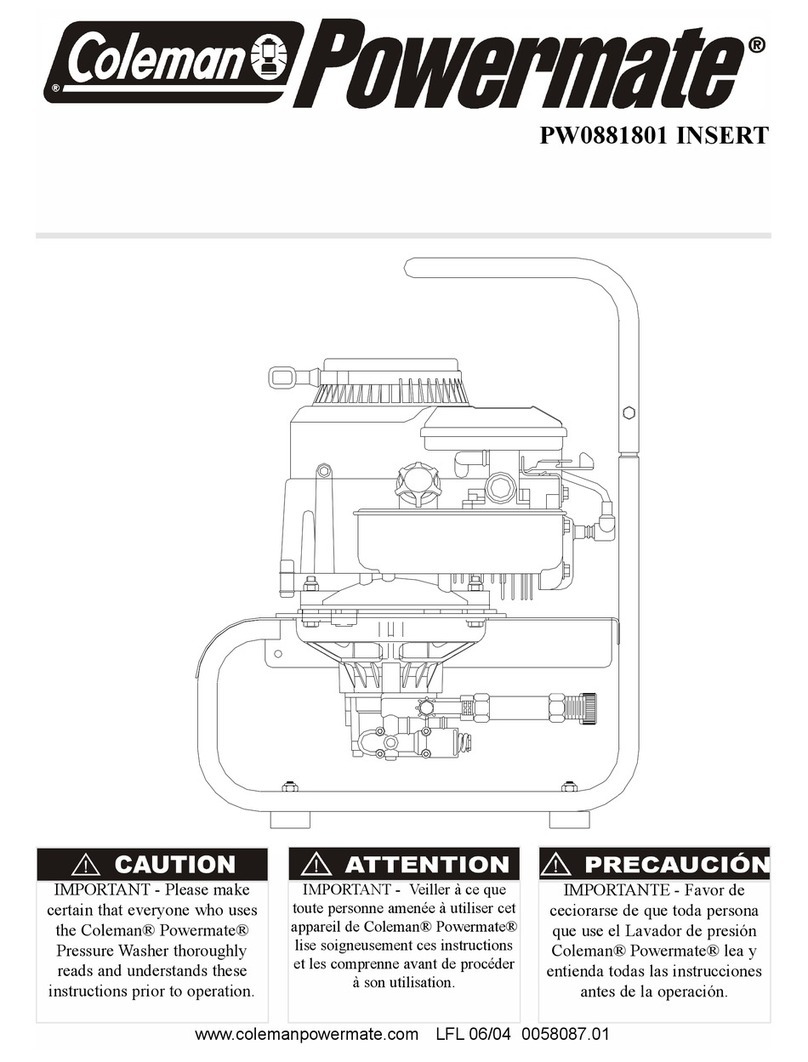
Powermate
Powermate PW0881801 User manual
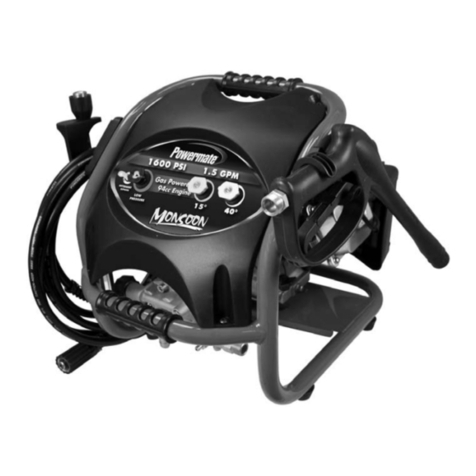
Powermate
Powermate PW0101600 User manual
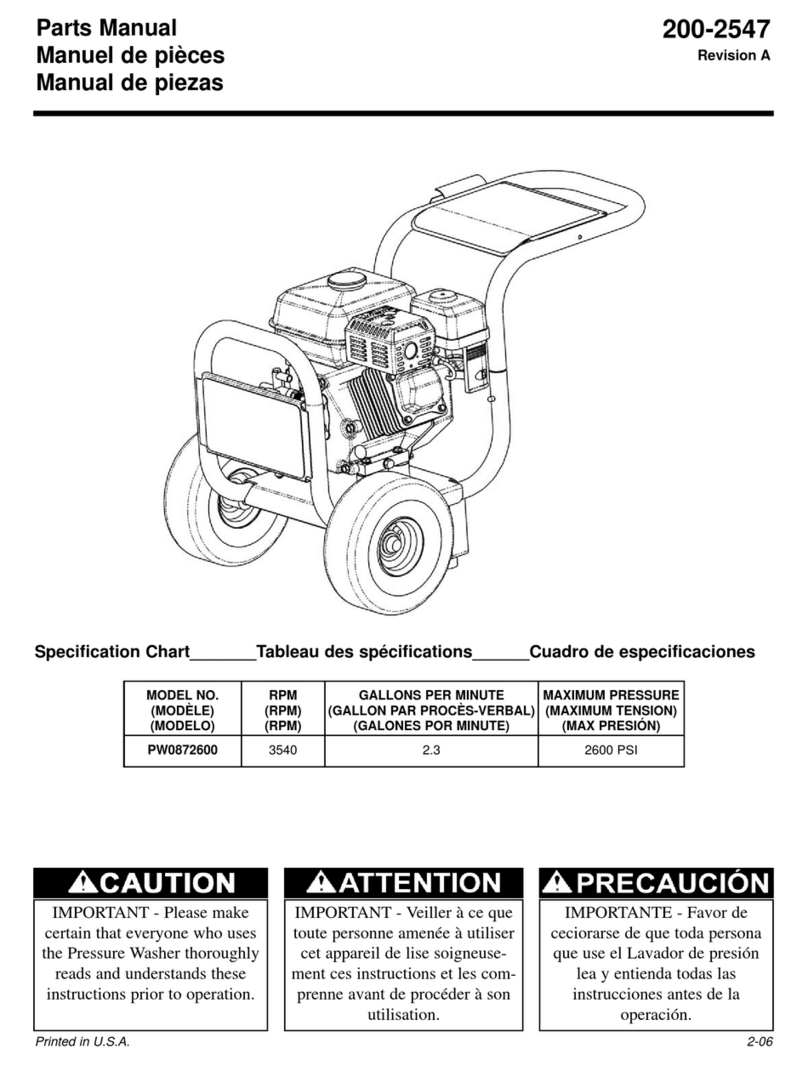
Powermate
Powermate PW0872600 User manual

Powermate
Powermate PW0501600 1600PSI User manual
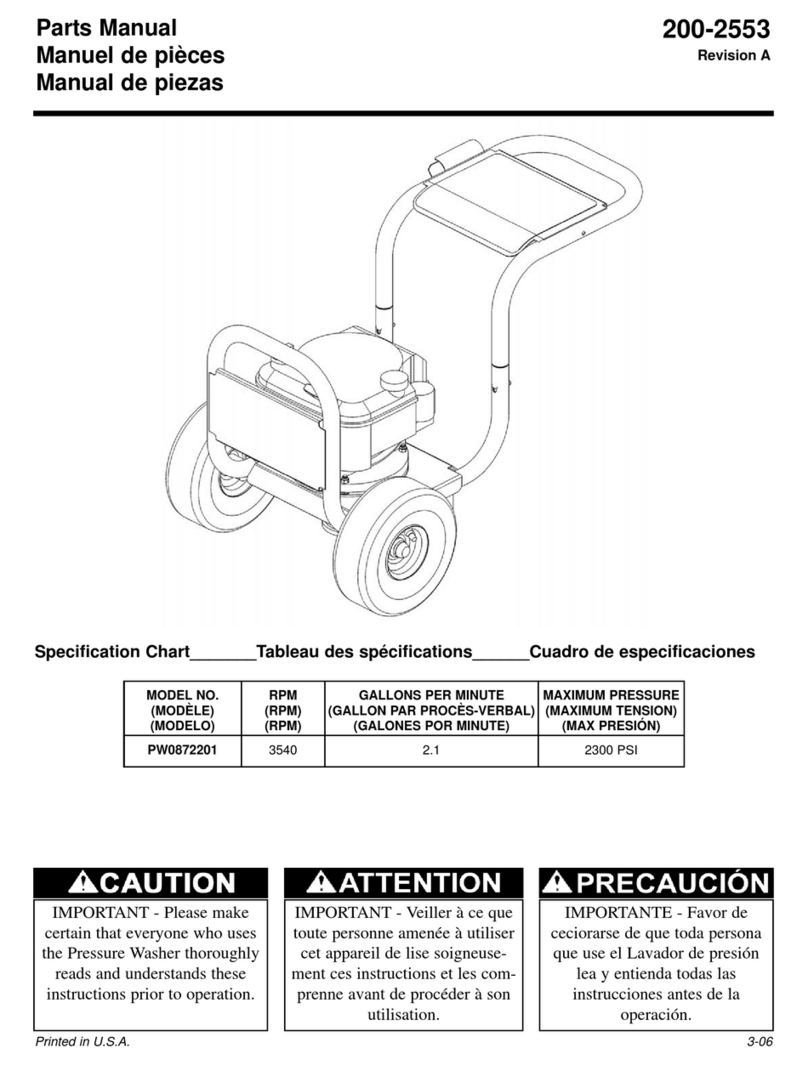
Powermate
Powermate PW0872201 User manual
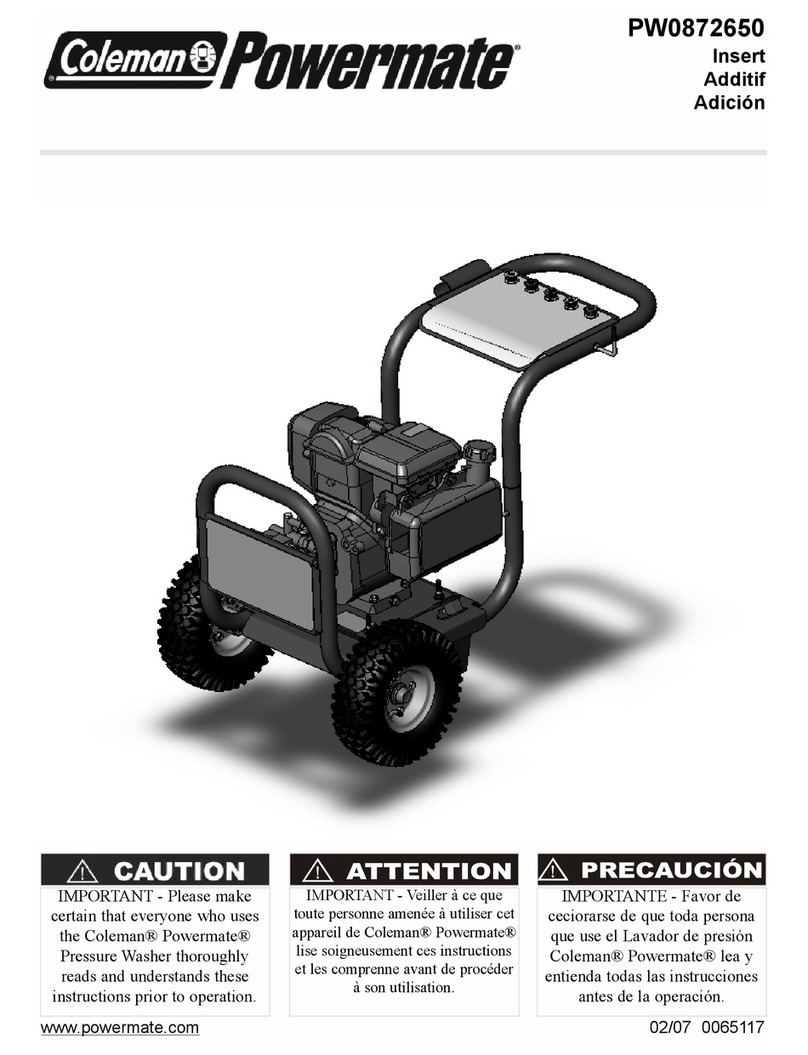
Powermate
Powermate PW0872650 User manual
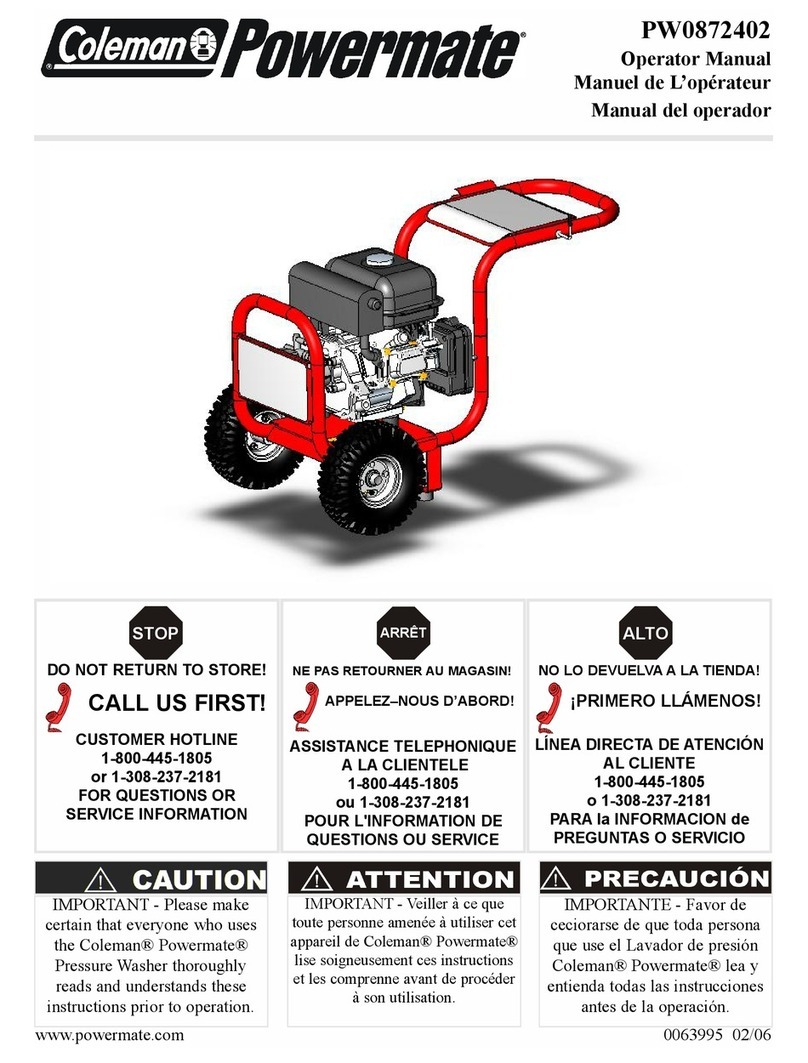
Powermate
Powermate PW0872402 User manual
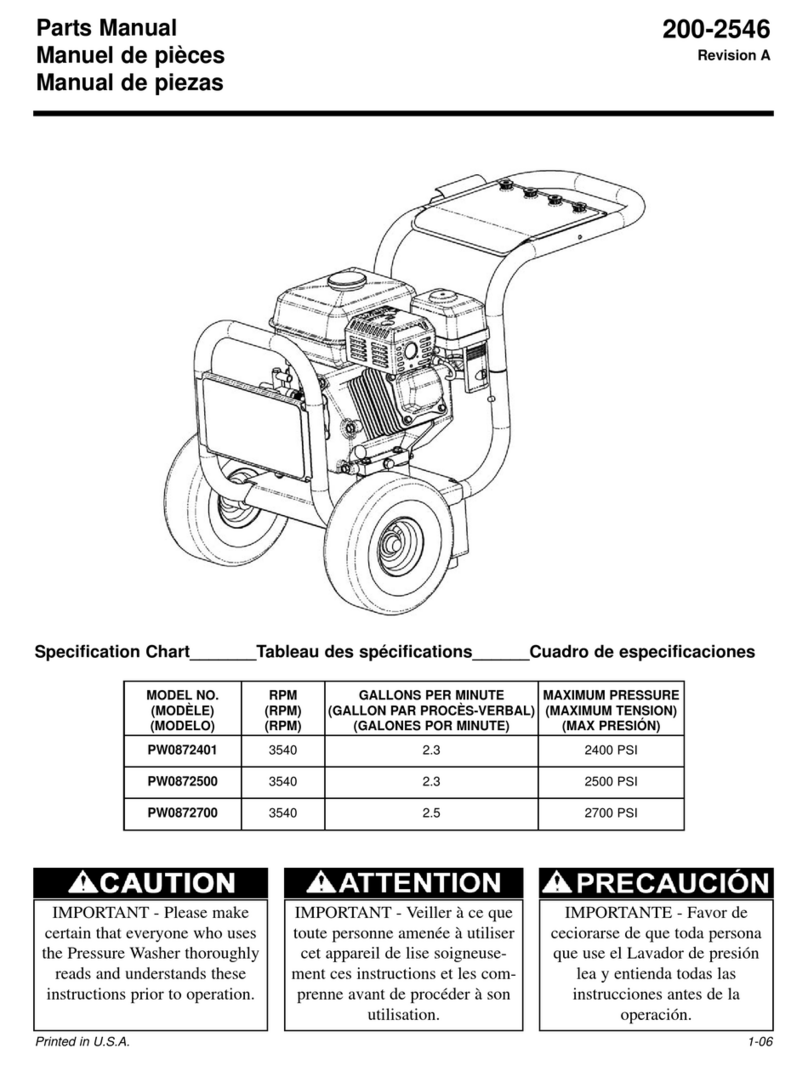
Powermate
Powermate PW0872401 User manual

Powermate
Powermate PW0102405 User manual

Powermate
Powermate pw0501400 User manual
